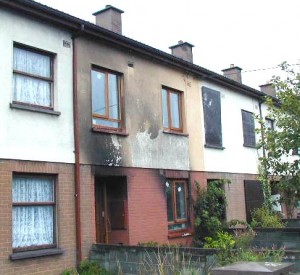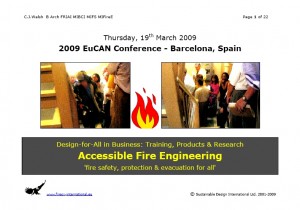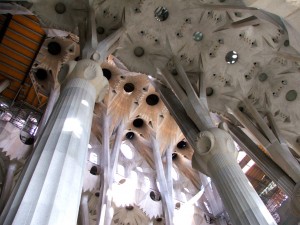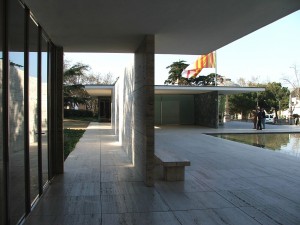2009-06-14: Ireland has no national standards or codes of practice of its own covering Building Accessibility or Fire Safety in Buildings. Instead, many people and organizations in this country will just switch to automatic pilot and – without thinking or questioning – adopt the following two standards of another jurisdiction as the default Irish National Standards …
British Standard BS 9999:2008 – Code of Practice for Fire Safety in the Design, Management and Use of Buildings … was published on 31 October 2008.
British Standard BS 8300:2009 – Design of Buildings and Their Approaches to Meet the Needs of Disabled People. This Code of Practice was published on 28 February 2009.
If Ireland does not quickly open its eyes … we will be sleep walking into a very problematic legal environment, as far as building accessibility and fire safety in buildings is concerned.
1. An Immediate Challenge
A Sub-Group (established at a meeting of the NSAI Accessibility-for-All Standards Consultative Committee WG1 held on Tuesday 2009-05-19) was tasked with developing a common position, suitable for application in Ireland and compatible with European Technical Harmonization, on the following issues:
- Clear Width of Internal & External Door Openings ;
- Turning Circles for Occupied Wheelchairs ;
- Car Parking Spaces ;
- Fire Safety Issues.
A series of coherent proposals will be presented to the next NSAI AASCC WG1 Meeting, on Friday 19th June 2009 … and, given the absence of Irish National Standards, it will also be suggested how these proposals may be confirmed as best current practice here.
.
2. Overview of BS 8300:2009 & BS 9999:2008
During the development of the Draft ISO Accessibility-for-All Standard, it has been unanimously agreed that Accessibility encompasses the full range of activity related to buildings: to approach, enter, use, egress from and evacuate a building independently, in an equitable and dignified manner (Introduction, 2nd Paragraph, Page 5). ‘Egress’ under normal, ambient conditions is distinguished from ‘Evacuation’ in the event of a fire emergency. Use of the word ‘Escape’ is discouraged in any circumstance. For the first time, fire safety texts have been fully incorporated into the main body of the Draft ISO Standard.
Accessibility within the British Standards Institution (BSI), on the other hand, is still segregated between BS 8300:2009 – approach, entry and use and BS 9999:2008 – fire evacuation. Conflicts and gaps in content naturally result from such a configuration, which can now be seen as outdated and fundamentally flawed.
This configuration has been replicated, in Irish Building Regulations, with the separate scopes of Part M / Technical Guidance Document M and Part B / Technical Guidance Document B. Integration between these 2 Technical Guidance Documents is very poor. In practice, fire safety for people with activity limitations is widely disregarded within the process of Fire Safety Certification in Ireland.
2.1 BS 8300:2009
BSI has arrogantly gone on a solo run, and decided to deviate from some very widely accepted concepts of accessibility, e.g. ‘clear width’ of a door opening (discussed in more detail later). The ‘Ergonomic Research’ supporting door opening forces of 30 N is at complete variance with earlier research in Britain and must, therefore, be strongly questioned. Perhaps, it is the case that the Fire Services in England & Wales re-asserted their authority, supported by reference to European Fire Product Standards with little if any input from the European Disability Sector, and insisted on a ‘definite’, i.e. high, closing force being exerted on the door leaves in fire resisting doorsets.
2.2 BS 9999:2008
People with disabilities have a right, recognized in international law after 3rd May 2008, to equal opportunity and non-discrimination in matters of building fire safety, protection and evacuation. A minimum response to Article 11 (Situations of Risk) in the 2006 United Nations Convention on the Rights of Persons with Disabilities is required, therefore, from fire regulators and code writers. Such a response is absent in British Standard BS 9999:2008.
A close examination of the fire safety texts relating to ‘disability’ in BS 9999:2008 shows that they have not been properly integrated into the ‘mainstream’ content. In fact, much of the content from the replaced BS 5588:Part 8 has just been grafted onto BS 9999, with very little change or alteration from the first version of Part 8 published in 1988 !
Compare Figure G.1 on Page 360 of BS 9999:2008 … with … Figure 4 on Page 8 of BS 5588:Part 8:1988 … both are exactly the same …
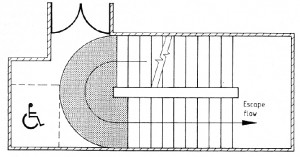
Two Critical Observations in relation to the ‘area of rescue assistance’ shown above:
– This drawing in BS 9999:2008 is in direct conflict with the text located directly above it … ‘where the wheelchair space is within a protected stairway, access to the wheelchair space should not obstruct the flow of persons escaping’ ;
but, more importantly …
– In BS 9999:2008, fire safety for people with activity limitations receives treatment which is superficial and merely token. Many times in relation to buildings generally, it is stated in Annex G.1, Page 359 …
‘A refuge needs to be of sufficient size both to accommodate a wheelchair and to allow the user to manoeuvre into the wheelchair space without undue difficulty.’
‘ In most premises, it is considered reasonable to have refuges of a size where each one is able to accommodate one wheelchair user. Where it is reasonably foreseeable that the proportion of disabled users in a building will be relatively high, or where the use of the premises is likely to result in groups of wheelchair users being present (e.g. some types of sporting, entertainment, transport or public assembly buildings), consideration should be given to increasing the size and/or number of refuges accordingly.’
‘ NOTE 3 Managers of sporting or other venues where a number of disabled people might be present are advised not to restrict the number of disabled people who can be admitted to that venue on the grounds of the size of refuges, since some disabled people who use mobility aids such as a wheelchair will be able to self-evacuate in the case of a real fire.’
and again in Annex G.2.2 on Page 367 …
‘Where it is reasonably foreseeable that the refuges will be used by more than one user (e.g. some types of sporting, entertainment, transport or public assembly buildings), … ‘
.
Within such an inadequate and token context, it is understandable that an unduly heavy reliance is placed on the practice of developing Personal Emergency Evacuation Plans (PEEPS) for individuals with activity limitations. See Paragraph #46.7a) on Page 248, which states …
‘ By taking into account the individual needs of a person when preparing a PEEP, management will be able to make any reasonable adjustments to the premises or procedures that are necessary.’
These Plans are flawed and discriminatory because they are:
– person specific ; and
– location specific ;
… with the underlying assumption in the text being that, beyond the specified location(s), the building is not properly accessible, i.e. does not meet the functional requirements of Parts B & M in the Building Regulations for England & Wales – or, in the case of Ireland, Parts B & M of our Building Regulations.
.
There are silly technical errors in BS 9999:2008, e.g. in Annex G.2.3 on Page 368, it states …
‘Unless a different order has been agreed with the fire authority, evacuation should normally be in the following order:
1) the fire floor ;
2) the floor immediately above the fire floor ; [This should read ‘the floors immediately above and immediately below the fire floor’ !]
3) other floors above the fire floor starting at the top storey ;
4) all remaining floors.’
.
A Technical Term is used in BS 9999:2008 – Place of Ultimate Safety – which complicates the already widely accepted term: ‘Place of Safety’. The definition provided for the British Term in Section 3: Terms & Definitions (#3.84, Page 17) is so vague that it is of no practical use to fire engineering designers, building managers or building users.
.
3. Comments: i) Clear Width of Door Openings
Paragraph #6.4.1, on Page 36 of BS 8300:2009 introduces a new understanding of ‘clear width’ for door openings, which is illustrated in Figure 11 (Page 37) … and also a new term ‘effective clear width’.
The new understanding of ‘clear width’ is a complete departure from the standard understanding, widely accepted throughout the world, which is shown in the bottom left hand drawing of Figure 11.
The new term ‘effective clear width’ will complicate the already difficult concept of ‘clear width’. Wasn’t the ‘clear width’ of a door opening always supposed to be ‘effective’, i.e. properly permit circulation for wheelchair users ?
However, the issue raised in the top right hand drawing of Figure 11 is valid …
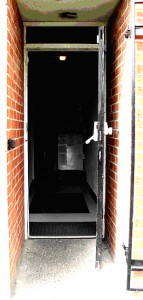
Solution: Retain the current international/European/national understanding of ‘clear width’ for door openings in Ireland … but include text, with supporting drawings, in Revised Technical Guidance Documents B & M to ensure that there is no encroachment on that ‘clear width’ caused by protruding door leaf ironmongery or, more importantly, where the door leaf itself cannot be fully opened to 90o-100o.
.
4. Comments: i) Clear Width of Door Openings in Existing Buildings
Table 2, on Page 37 of BS 8300:2009, permits the ‘clear width’ for door openings in existing buildings to be reduced significantly below 800mm.
If buildings of historical, architectural and cultural importance are properly identified, and proper allowance is made for these specific building types in Revised Technical Guidance Documents B & M … there is no need to permit a general reduction in the ‘clear width’ for door openings in existing buildings.
Solution: Clearly indicate in the Revised Technical Guidance Document M that the last ‘Existing Buildings’ Column on the right of Table 2 in BS 8300 should be disregarded.
.
5. Comments: ii) Turning Circles for Occupied Wheelchairs
Down through the years, it has been just possible to communicate the concept of the ‘wheelchair turning circle’ to building designers and urban planners … whether it be the older 1.5m diameter circle or the newer 1.8m diameter circle.
The new Figures and Tables in Annexes C.3 and C.4 of BS 8300:2009 will be difficult to communicate … and may be a complication too far ?
.
6. Comments: iv) Fire Safety Issues
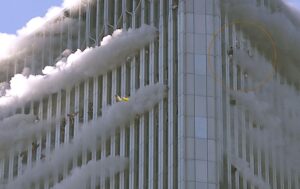
The Recommendations contained in the 2005 & 2008 National Institute of Standards & Technology (USA) Reports on the WTC 9-11 Incident in New York provide an invaluable and essential empirical basis for the practice of effective fire engineering design in today’s built environment.
The first of these two reports has special relevance for NSAI AASCC WG1 because the typical problems encountered by people with activity limitations during a ‘real’ building fire incident have been highlighted by NIST and closely investigated. As a result, three important fire engineering keywords have been re-stated with strong emphasis: ‘reality’ – ‘reliability’ – ‘redundancy’. And, a new key phrase in relation to way finding during evacuation has been introduced to the everyday practice of fire engineering design: ‘intuitive and obvious’.
The 2005 NIST Report, particularly, must be given proper consideration during the development of any reputable fire safety related standard or code of practice for the following reasons:
– at the time of the ‘real’ fire incident, approximately 8% of building users were people with disabilities, with 6% having mobility impairments ; [The percentage of ‘building users with activity limitations’ exceeded the 8% quoted above.]
– NIST found that the average surviving occupant in the buildings descended stairwells at about half the slowest speed previously measured for non-emergency/test evacuations. This raises a serious question over the use of standard movement times in fire engineering design calculations for evacuation ;
– NIST strongly recommended that fire-protected and structurally hardened lifts (elevators) should be installed in buildings to facilitate the evacuation of building users with disabilities, and to improve emergency response activities by providing timely emergency access to firefighters ; [In Ireland, building designers have already adopted this approach by constructing cores of reinforced concrete … even in the absence of European/national standards.]
– it was recommended that evacuation routes should have consistent layouts, and be ‘intuitive and obvious’ for all building users, including visitors who may be unfamiliar with the building, during evacuations ;
– NIST recommended that staircase capacity and stair discharge door widths should be adequate to accommodate contraflow in circulation spaces, i.e. the simultaneous emergency access by firefighters into a building and towards a fire, while building users are still moving away from the fire and evacuating the building. This has implications for the minimum clear width of all fire evacuation staircases. Wider staircases facilitate the assisted evacuation and rescue of people with disabilities.
.
No consideration was given in BS 9999:2008, however, to any of the Recommendations contained in the 2005 & 2008 NIST Reports … there is not even a mention of either Report in the Bibliography (Pages 423-429).
– For such an important national standard in Europe – BS 9999:2008 – there is no understanding demonstrated of the Fundamental Functional Requirement for Public Safety in Buildings …
Buildings shall remain structurally stable and serviceable …
1. while people are waiting in ‘Areas of Rescue Assistance’ ; and
2. until all of these people can be rescued by Firefighters and can reach a ‘Place of Safety’, which is remote from a fire building – with an assurance of individual health, safety & welfare for the people involved ;
– There is a reference to ‘normal movement times’ which are used to calculate evacuation times in Mobility-Impaired People (Paragraph #46.2, Page 247), even though it was found by NIST that the average surviving occupant in the WTC Towers descended stairwells at about half the slowest speed previously measured for non-emergency evacuations. In a ‘real’ fire incident, there is no such thing as ‘normal’ or ‘standard’ evacuation movement times, and the idea that any building must be clear of occupants within a very short timeframe, e.g. 2.5-3.5 minutes, is ludicrous ;
– In the sensitive area of the Resistance to Damage of Enclosing and Separating Partitions (Paragraph #21.2.5 on Page 101) surrounding Firefighting Shafts, it is still permissible in BS 9999:2008 to use non-robust construction, e.g. lightweight plasterboard. Fire-Induced Progressive Collapse is not discussed in the BS 9999 … and neither is Disproportionate Collapse, which is one of the functional requirements – A3 – in Part A of the Building Regulations for England & Wales (and Ireland !) ;
– Although in Wheelchair Users (Paragraph #46.3 on Page 247), it is stated …
‘It should be noted that it can take as many as four people to use an evacuation chair safely and effectively.’
… the dimensions for the minimum width of staircases in Width of Escape Stairs (Table 14 on Page 88) and Firefighting Stairs (Paragraph #21.3.2 on Page 106) disregard the guidance given on Page 247 … and ignore the minimum clear staircase width (1.5m) required to safely assist the evacuation of a person in a manual wheelchair …
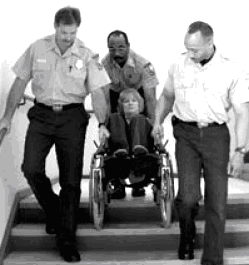
And … for some unexplained reason, handrails are permitted to intrude into the ‘clear width’ of a firefighting staircase in BS 9999:2008 (Paragraph #21.3.2, Page 106).
Please note well … this method (shown below) of assisting the evacuation of a person in a manual wheelchair is NOT correct. It is not possible to support any weight by holding the foot rests on a manual wheelchair, or by grasping the wheelchair by the front wheels …
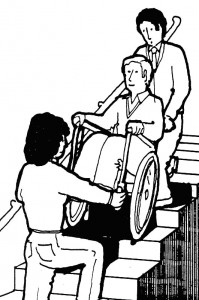
Manual handling of occupied wheelchairs in a fire evacuation staircase, even with adequate training for everyone directly and indirectly involved, is hazardous for the person in the wheelchair and those people – minimum three – giving assistance.
The weight of an average unoccupied powered wheelchair, alone, makes manual handling impractical. All lifts (elevators) in new buildings should, therefore, be capable of being used for evacuation in a fire situation. Lifts (elevators) in existing buildings, when being replaced or undergoing a major overhaul, should then be made capable of use for this purpose.
.
Contraflow Circulation, i.e. the simultaneous emergency access by firefighters into a building and towards a fire, while building users are still moving away from the fire and evacuating the building, has not been considered at all in BS 9999:2008.
A clear staircase width of 1.5m provides sufficient space for a mobile person to evacuate (700 mm) and a heavily protected and equipped firefighter to simultaneously move in the opposite direction (800 mm) …
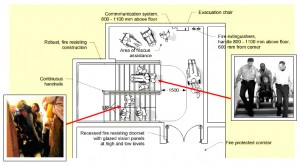
Human Behaviour in Fires should have been discussed in far more detail in BS 9999:2008 … but wasn’t. It is important for fire engineering designers to understand that the ‘real’ people who use ‘real’ buildings every day of every week, in all parts of the world, have widely differing ranges of human abilities and activity limitations … they are different from each other, and they will react differently in a fire emergency.
Building users need to be Skilled for Evacuation to a place, or places, of safety remote from a fire building. In the case of people with a mental or cognitive impairment, there is a particular need to encourage, foster and regularly practice the adaptive thinking which will be necessary during a ‘real’ fire evacuation.
Meaningful Consultation with every person known to occupy or use a building, for the purposes of receiving his/her active co-operation and obtaining his/her informed consent (involving a personal representative, if necessary), is an essential component of adequate pre-planning and preparation for a fire emergency.
Adequate Warning of a fire incident in a building should be communicated well in advance of the time when it is necessary to act and should continue for the full duration of the incident. Warnings should be informative, and easily assimilated in a form (e.g. oral, written, braille) and language understood by the people using the building.
Panic attacks, during evacuation in a ‘real’ fire incident, exist. The 2005 National Building Code of India refers extensively to this issue.
Solution: To resolve the technical inadequacies, inconsistencies and content gaps in BS 9999:2008 … it will be necessary to revise Technical Guidance Document B in Ireland. Fire safety, protection and evacuation from buildings for people with disabilities must be comprehensively included in the process of Fire Safety Certification.
.
7. Conclusions – BS 9999:2008 & BS 8300:2009
There are many gaps and conflicts between these two British Standards, principally because … they are two separate standards … drafted by two different Technical Committees within the British Standards Institution (BSI).
Because of its deviation from widely accepted concepts of accessibility and its tortuous use of terminology, BS 8003:2009 will have an adverse impact on the practice of Accessibility Design in Ireland … and has already complicated the development of the ISO Accessibility-for-All Standard (DIS ISO 21542).
Arrogance within BSI is not the only reason for such deviations. Distorting the European Union Single Market, for the purpose of introducing technical barriers to trade, is common in Britain … refer to the ‘deemed-to-satisfy’ status of the Approved Documents in the Building Regulations for England & Wales … and the Fire Protection Association’s ‘LPC Sprinkler Rules’.
Input from the Disability Sector during the drafting of BS 9999:2008 was not at all sufficient to ensure that there was a meaningful consideration of the problems encountered by people with activity limitations during a ‘real’ building fire incident. The necessary range of available and effective fire engineering solutions has not, therefore, been presented in the standard.
In addition … the complete and abject failure to consider the important Recommendations contained in the 2005 & 2008 National Institute of Standards & Technology (USA) Reports on the WTC 9-11 Incident in New York was an inexcusable and unforgivable technical oversight.
The result is a crassly inadequate, discriminatory and deeply flawed national fire safety standard in Great Britain & Northern Ireland. BS 9999:2008 became obsolete on the very day of its publication !
.
.
Postscript
Please refer to our 1999 Submission to the Department of the Environment & Local Government, in Dublin, concerning the use of British Standard BS 5588:Part 8 in Ireland …
http://www.sustainable-design.ie/arch/submissions.htm
Following this Submission, our understanding is that an ‘Internal’ Working Party was established within the Department. However, the Working Party never reported. No proper response to this Submission has ever been received from the Minister or the Department.
.
On 29th November 2006, similar and very polite comments were sent directly to the British Standards Institution (BSI) by e-mail. Receipt of this e-mail was never acknowledged by anyone in BSI.
The contents of the e-mail were ignored.
.
.
END



